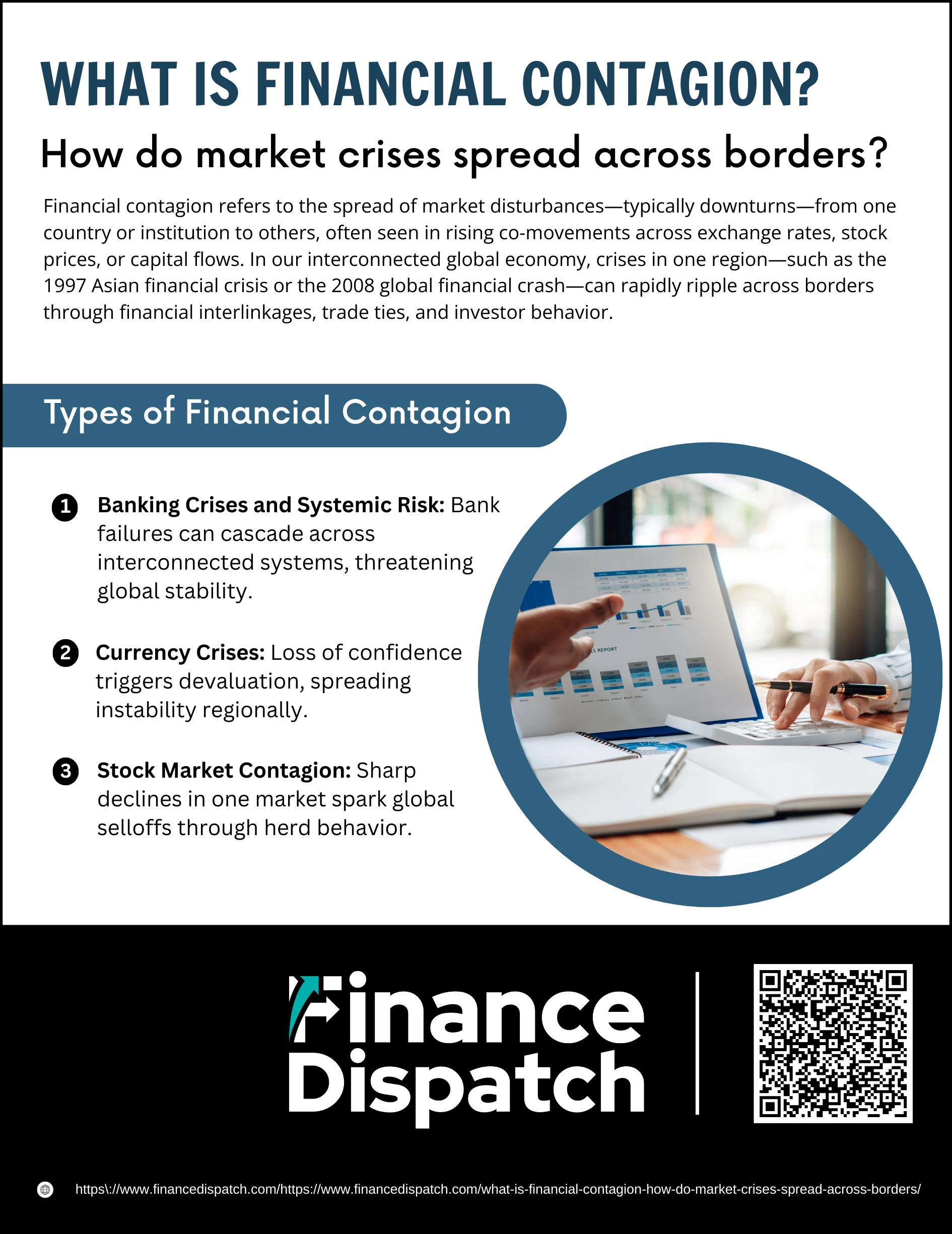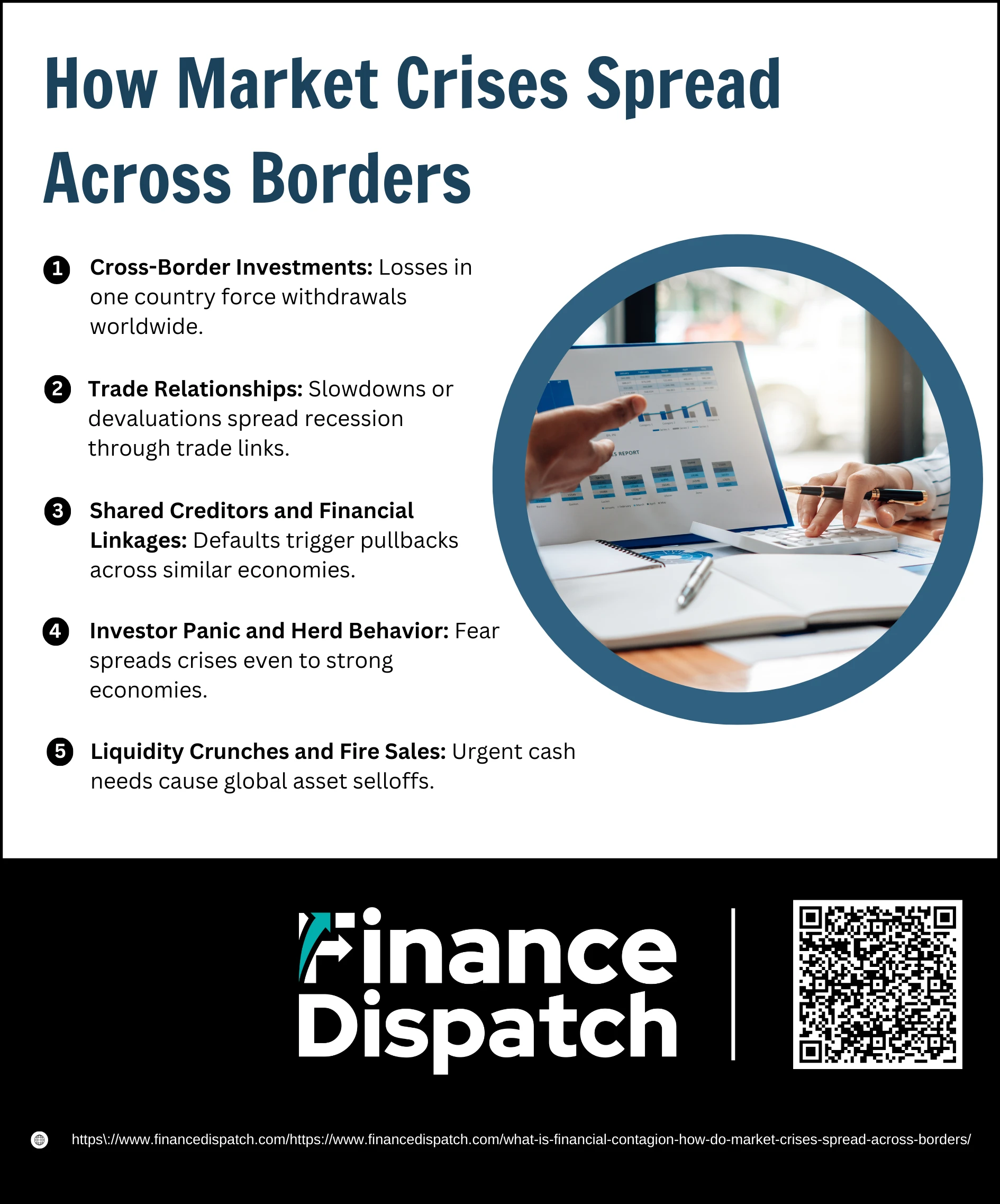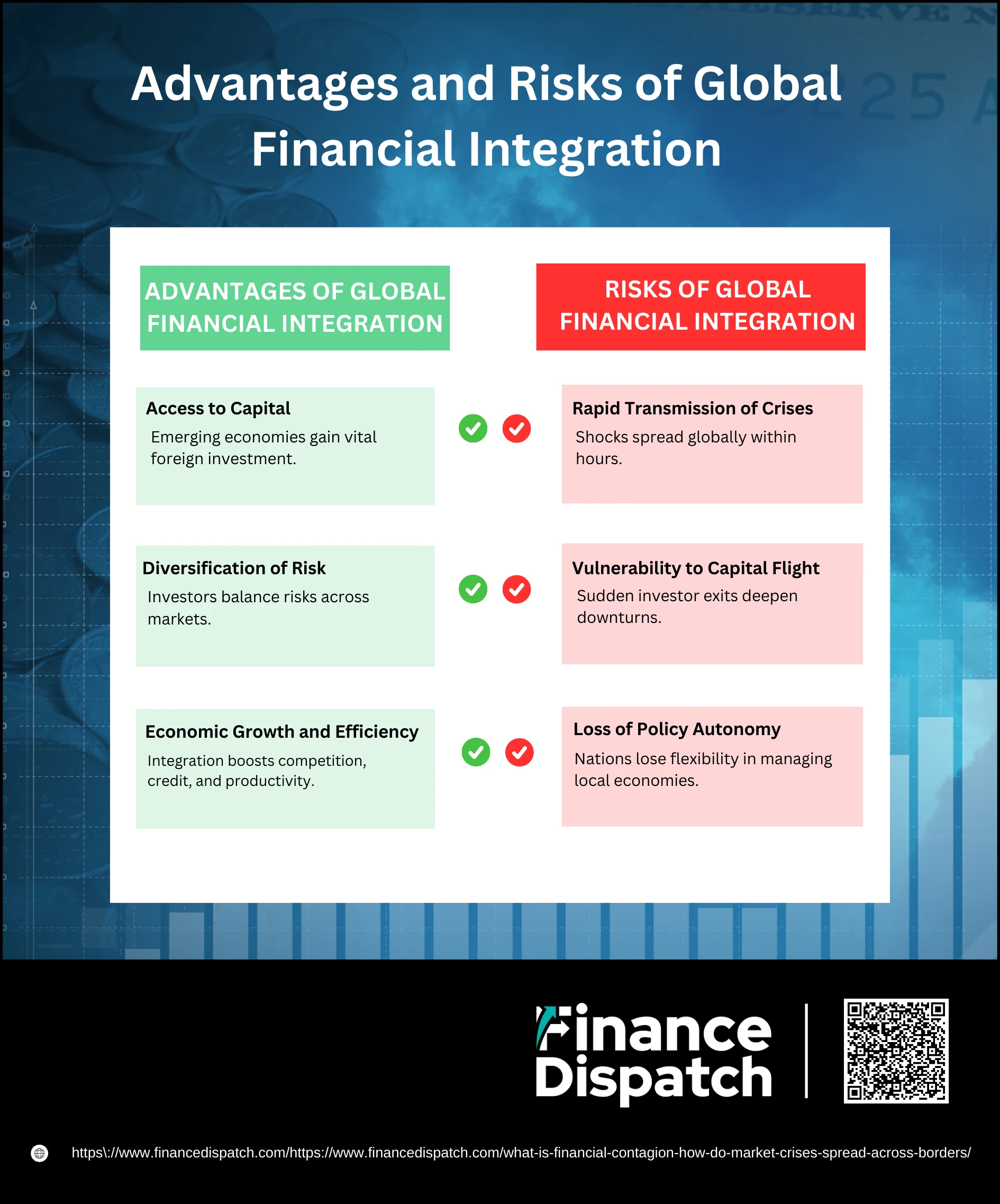In today’s global economy, financial markets are more connected than ever before. A crisis that begins in one country—whether it’s a banking collapse, a currency devaluation, or a stock market shock—can quickly spread to others, disrupting economies far beyond its origin. This chain reaction is known as financial contagion. Much like the way a virus spreads through populations, financial contagion transmits instability across borders, often magnifying the original problem into a global crisis. Understanding how and why this happens is essential, not only for policymakers who must respond to such crises but also for investors and businesses whose decisions are shaped by these ripple effects.
What is Financial Contagion?
Financial contagion refers to the rapid spread of financial shocks or instability from one market, sector, or country to others. It is often described as a “domino effect,” where a crisis in one part of the financial system triggers disturbances across borders, even in economies that appear stable. This can happen through interconnected banking systems, cross-border investments, global trade relationships, or shifts in investor confidence. What makes contagion particularly dangerous is its ability to amplify the original shock—turning a local disruption into a global crisis that affects currencies, stock markets, and entire economies.
 Types of Financial Contagion
Types of Financial Contagion
Financial contagion is not a single event but a phenomenon that can appear in different forms, depending on which part of the financial system is hit first. A banking failure, a currency collapse, or a stock market shock may look different on the surface, but they all share the same feature: the ability to spread instability far beyond their point of origin. Below are the main types of financial contagion.
1. Banking Crises and Systemic Risk
Banking crises occur when people lose trust in financial institutions, leading to mass withdrawals, insolvency, and even bank collapses. Because banks are deeply interconnected through loans and shared assets, the failure of one institution can cascade across the system. This creates systemic risk—where the entire financial system is threatened, not just individual banks. The 2008 collapse of Lehman Brothers is a prime example: its failure quickly spread panic across global banking networks.
2. Currency Crises
A currency crisis happens when investors suddenly lose confidence in a country’s ability to maintain its currency value, leading to rapid devaluation. Once this occurs, investors often pull capital from neighboring economies they believe might face similar problems, sparking competitive devaluations. This can create a regional chain reaction, as seen during the 1997 Asian Financial Crisis, when Thailand’s baht collapse spread to Indonesia, Malaysia, and South Korea.
3. Stock Market Contagion
Stock market contagion arises when a sharp drop in one market prompts investors worldwide to sell off their holdings elsewhere. Herd behavior and the speed of global trading can cause selloffs to spread within hours, regardless of a country’s underlying fundamentals. This was visible during the 2008 Global Financial Crisis, where U.S. market turmoil quickly triggered declines across Europe, Asia, and emerging economies.
 Key Mechanisms of Financial Contagion
Key Mechanisms of Financial Contagion
Financial contagion spreads because markets, economies, and investors are linked in ways that transmit shocks quickly and sometimes unpredictably. These mechanisms show how a seemingly local financial problem can ripple outward and trigger wider instability. Understanding them helps explain why crises rarely remain contained within one country or sector.
1. Interconnectedness of Financial Markets
Banks, investment funds, and corporations operate across borders through loans, investments, and derivative contracts. If one major institution fails, the shock can spread through these connections. For example, when U.S. mortgage-backed securities collapsed in 2008, banks in Europe and Asia holding the same assets faced immediate losses, illustrating how tightly woven global finance has become.
2. Investor Behavior and Herding
Human psychology plays a big role in contagion. When investors see others selling assets or pulling money from a market, they often follow suit, even without strong evidence. This herd behavior accelerates panic and can turn a small problem into a massive selloff. A cycle of fear-driven decisions magnifies losses and spreads instability across markets.
3. Globalization and Cross-Border Capital Flows
In a globalized world, capital moves at lightning speed. When confidence in one country’s economy drops, foreign investors can quickly withdraw funds, leading to sharp currency depreciation and capital shortages. These movements often spill into other economies with similar vulnerabilities, showing how global integration is both a strength and a weakness.
4. Trade Linkages and Competitive Devaluation
Countries linked through trade can transmit financial shocks indirectly. When one nation devalues its currency to protect exports, trading partners may feel forced to do the same to stay competitive. This chain of devaluations spreads instability across regions, as seen during the Asian Financial Crisis of 1997 when Thailand’s baht collapse set off a regional wave of currency turmoil.
5. Liquidity Constraints and Fire Sales
During financial stress, institutions and investors often scramble to raise cash. To do so, they sell off their most liquid assets, such as government bonds or blue-chip stocks, even if those assets are fundamentally strong. These fire sales depress prices across global markets, pulling healthy economies into the crisis. This explains why contagion often spreads beyond directly affected countries.
Bottom of Form
Historical Examples of Financial Contagion
Financial contagion is not just a theoretical concept—it has shaped global markets through several major crises. Each episode shows how quickly local financial problems can snowball into international turmoil, destabilizing economies far beyond their starting point.
1. Asian Financial Crisis (1997) – Began in Thailand with the collapse of the baht and spread rapidly across Southeast Asia, triggering currency devaluations, stock market crashes, and deep recessions in multiple countries.
2. Global Financial Crisis (2008) – Originated in the U.S. subprime mortgage market and spread worldwide through interconnected banks and financial products, leading to the worst global recession since the Great Depression.
3. European Debt Crisis (2010) – Sparked by concerns over Greece’s government debt, it spread to Portugal, Ireland, Italy, and Spain, undermining confidence in the Eurozone’s stability.
4. COVID-19 Shock (2020) – What started as a public health emergency quickly became a financial crisis, causing stock market collapses, oil price crashes, and global supply chain disruptions.
 How Market Crises Spread Across Borders
How Market Crises Spread Across Borders
A financial crisis in one country can send shockwaves across the globe within days, sometimes even hours. This happens because modern economies are deeply interconnected through trade, investment, and capital flows. While these linkages bring benefits in normal times, they also act as transmission lines during times of stress. Below are the main ways crises jump borders and destabilize other economies.
1. Cross-Border Investments
Globalization has tied investors, banks, and corporations to multiple countries through foreign direct investments, portfolio holdings, and joint ventures. When a crisis erodes asset values in one country, investors often need to cover losses by selling assets elsewhere. For example, during the 2008 financial crisis, U.S. mortgage-backed securities collapsed, and European banks that held them suffered large losses. To restore balance sheets, these banks withdrew funds from other regions, spreading distress far beyond the U.S. housing market.
2. Trade Relationships
Strong trade ties mean that a slowdown in one country can reduce demand for imports, harming its trading partners. Likewise, when a country devalues its currency to regain competitiveness, its neighbors may feel forced to follow suit, sparking a wave of competitive devaluations. This was evident in the Asian Financial Crisis of 1997, when Thailand’s baht devaluation led to similar moves across Indonesia, Malaysia, and South Korea, dragging the entire region into recession.
3. Shared Creditors and Financial Linkages
International banks and funds often lend to or invest in several countries with similar profiles. If one borrower defaults, creditors may reduce exposure to other countries they perceive as risky, regardless of actual differences in economic fundamentals. This “common creditor effect” was seen in Latin America during the 1980s debt crisis: once Mexico announced it could not service its debt, investors began pulling money from Argentina, Brazil, and Chile—even though these countries faced different challenges.
4. Investor Panic and Herd Behavior
Crises are not driven by numbers alone—psychology plays a powerful role. When investors see turmoil in one country, they often assume similar risks exist elsewhere and rush to sell. This herd mentality can lead to indiscriminate capital flight, where even fundamentally strong economies suffer losses. In 2010, when Greece revealed its budget deficit was much larger than reported, panic spread to other Eurozone countries like Portugal and Spain, even though their fiscal situations were not identical.
5. Liquidity Crunches and Fire Sales
In periods of stress, investors and institutions need cash quickly to meet obligations. To raise funds, they sell the most liquid assets, such as government bonds or blue-chip stocks. This “fire sale” dynamic drives down prices in markets unrelated to the original crisis. For example, when Lehman Brothers collapsed in 2008, investors liquidated assets across Asia and Europe, causing sharp declines in global stock indexes—even in countries with little direct exposure to U.S. subprime mortgages.
The Role of Investor Psychology
Investor psychology is one of the most powerful forces behind financial contagion. In times of uncertainty, fear and panic often outweigh rational analysis, leading investors to make quick decisions based on emotion rather than fundamentals. This behavior creates herd effects, where individuals follow the crowd by selling assets or pulling out investments simply because others are doing the same. Such actions can turn a local market shock into a global crisis as waves of selling spread rapidly across borders. Behavioral finance research shows that during crises, loss aversion and information cascades dominate—investors fear further losses and assume that others have access to negative information, so they imitate their actions. This self-reinforcing cycle magnifies financial instability, showing that market contagion is not only about economics but also about human behavior.
 Advantages and Risks of Global Financial Integration
Advantages and Risks of Global Financial Integration
Global financial integration has reshaped the way economies interact. Capital, investments, and financial products now move across borders at lightning speed. This interconnectedness can stimulate growth and efficiency, but it also creates channels for crises to spread far and wide. Let’s look at both the benefits and the downsides in more depth.
Advantages of Global Financial Integration
1. Access to Capital
Emerging economies and developing nations can attract foreign direct investment and portfolio inflows that may not be available domestically. This helps fund infrastructure, business expansion, and social development. For example, many Asian economies have relied on international capital to build factories, modernize cities, and support rapid industrial growth.
2. Diversification of Risk
Investors gain the ability to spread their portfolios across different countries and asset classes. This reduces reliance on any single market and cushions against local downturns. A U.S. investor, for instance, might hold Asian equities and European bonds to balance domestic risks, improving overall portfolio resilience.
3. Economic Growth and Efficiency
Integration encourages competition among financial institutions, lowers borrowing costs, and improves access to credit for businesses and consumers. It also promotes the transfer of financial technology and best practices across borders. Over time, this enhances economic efficiency and raises global productivity.
Risks of Global Financial Integration
1. Rapid Transmission of Crises
The same channels that allow money to flow freely also transmit shocks with alarming speed. A banking failure, currency collapse, or stock market crash in one region can ripple worldwide in hours. The 2008 Global Financial Crisis, which began in the U.S. mortgage market, spread through international banking linkages and caused recessions across Europe and Asia.
2. Vulnerability to Capital Flight
Foreign investors may withdraw funds quickly when confidence falters. Such capital flight can lead to sudden currency depreciation, falling asset prices, and credit shortages. The Asian Financial Crisis of 1997 demonstrated this risk: billions in short-term capital exited Southeast Asian economies within weeks, worsening the downturn.
3. Loss of Policy Autonomy
Countries integrated into global financial markets may find it difficult to manage domestic economic policies independently. Central banks, for example, might be forced to adjust interest rates not based on local needs but to maintain investor confidence and protect currency stability. This limits governments’ flexibility to respond to internal challenges like unemployment or inflation.
Strategies to Prevent or Contain Financial Contagion
While financial contagion cannot be eliminated entirely, its risks can be reduced through strong safeguards and coordinated responses. Governments, regulators, and financial institutions play a vital role in building resilience, ensuring that shocks in one market do not spiral into global crises. Below are key strategies used to prevent or contain contagion.
1. Strengthening Financial Regulations – Enforcing stricter capital requirements, liquidity standards, and risk management practices helps banks and institutions remain stable during times of stress.
2. Improving Transparency and Information Sharing – Clear reporting and open communication reduce uncertainty, allowing investors and policymakers to make informed decisions instead of reacting to rumors.
3. Conducting Stress Tests and Risk Assessments – Regular simulations of crisis scenarios allow financial institutions to identify vulnerabilities and prepare effective contingency plans.
4. Enhancing International Cooperation – Coordinated action between central banks, regulators, and organizations like the IMF can provide emergency support and stabilize global markets.
5. Building Financial Safety Nets – Mechanisms such as deposit insurance schemes, emergency lending facilities, and stabilization funds can restore confidence and prevent panic-driven withdrawals.
6. Encouraging Portfolio Diversification – Investors can protect themselves by spreading investments across different markets and asset classes, reducing the impact of localized shocks.
The Future of Financial Contagion in a Globalized World
As global markets become even more connected through technology, trade, and digital finance, the risk of financial contagion is likely to evolve rather than disappear. New vulnerabilities are emerging—from high-frequency trading and cryptocurrencies to cyberattacks and climate-related shocks—that could trigger rapid, borderless disruptions. At the same time, the speed of capital flows means crises can spread in minutes, not weeks, amplifying their impact. Yet, there are also opportunities: stronger international cooperation, advanced risk management tools, and lessons learned from past crises can help build more resilient systems. The future of financial contagion will be defined by this balance—between growing interdependence that raises risks and improved safeguards that aim to contain them.
Conclusion
Financial contagion shows how deeply interconnected today’s world has become—where a crisis in one corner of the globe can quickly ripple across markets and economies far beyond its origin. From banking failures and currency collapses to stock market selloffs, the spread of instability highlights both the strengths and vulnerabilities of global integration. While it is impossible to eliminate contagion entirely, stronger regulations, better risk management, and international cooperation can reduce its impact and restore confidence during turbulent times. Understanding how contagion works is not just valuable for policymakers and financial institutions—it also helps investors and ordinary people recognize the importance of resilience in an unpredictable global economy.



